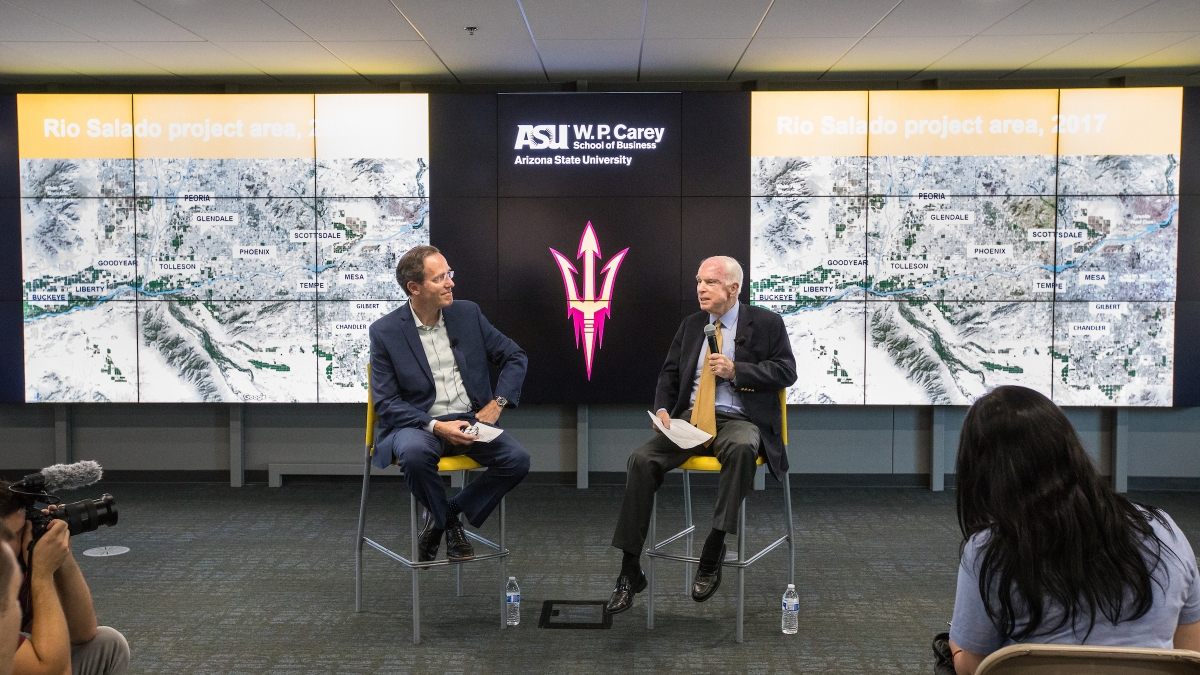Editor's note: This story is being highlighted in ASU Now's year in review. To read more top stories from 2017, click here.
U.S. Sen. John McCain (R-AZ) and Arizona State University gave a preview Friday of a new effort to transform the entire Salt River bottom through metro Phoenix into an urban and environmental amenity, a project organizers hope would engage the creativity of the university community.
The area being considered runs from Granite Reef Dam in the East Valley to the Tres Rios Wetlands in the West Valley.
“We’re looking at this whole stretch,” said Wellington “Duke” Reiter, senior adviser to ASU President Michael M. Crow.
“Anybody who drives past Tempe Town Lake realizes what a success this is,” McCain said. “Every mayor wants a Tempe Town Lake.”
McCain said he is inspired by the river walk in San Antonio, Texas, as well as similar efforts underway in Los Angeles, Atlanta and Dallas. “This Valley is going to grow,” he said. “What kind of a place do you want your kids to grow up in?”
“We want to make this an example to the rest of the state, as well as the nation,” McCain said. “I’ll tell you whose plan it is, and who’s going to make it work, and that’s ASU.”
The immediate next step is to form a steering committee and establish timelines.
Reiter said the project would be managed by ASU, but that ASU would not be the driver.
“The university will be a convener of community interests and key stakeholders to make sure all voices are heard and reflected in the work to be done,” he said.
It will be a project that utilizes much of the expertise at the university, including hydrology, biology, design, architecture, planning, finance and sustainability. Students will be involved in the design and research.
“How we’re going to get this done is a function of the many layers of expertise at this university,” Reiter said.
The project will not be simply a continuation of Tempe Town Lake, but a balance between the two developed areas in the riverbed now: the environmental amenities at the Nina Mason Pulliam Rio Salado Audubon Center in Phoenix, and the commercial/recreational nature of Tempe Town Lake.
McCain stressed it won’t be an office park on a riverbank. If amenities like bike trails and picnic areas aren’t there, business won’t follow.
“If it’s not nice, they won’t want to locate there,” he said.
Reiter characterized the project as a “string of assets.”
“Nothing has been developed yet,” he said. “We’d like to set the course now.”
A significant number of stakeholders have announced their support for the proposal. They include the mayors of Mesa, Scottsdale, Phoenix, Avondale and Buckeye; the Arizona Chamber of Commerce; the Gila River and Salt River Pima-Maricopa tribes; APS, SRP, the EPA, the Army Corps of Engineers and all Arizona environmental groups, McCain said.
“By the way, it’s got to be sooner rather than later,” McCain said. He said he did not want the project held up by endless study and review. He urged a cap of two years on planning and design before groundbreaking. “It’s going to be our timeline,” he said.
McCain, who told the students he is starting to think about his legacy, explained why he is supporting the project.
He brought up State Farm’s new regional headquarters on the lake in Tempe and the company’s recent hiring of 2,000 employees. Total investment around the lake is more than $1 billion, he said.
“Would they be doing that without a Tempe Town Lake?” he said. “Of course not.”
Part of the design will incorporate conservation, Reiter said.
“We want to make this a water-positive project,” he said.
The project is being dubbed Rio Salado 2.0.
“Don’t think it’s going to be easy,” McCain said. “There’s going to be opposition from the right and the left.”
“We’re going to make America great again,” he closed with a grin.
Top photo: Sen. John McCain joins ASU's Wellington "Duke" Reiter, senior adviser to ASU's president, to discuss Rio Salado 2.0 in McCord Hall on the Tempe campus Friday. Photo by Charlie Leight/ASU Now
More Environment and sustainability

Mapping the way to harvesting water from air
Earth’s atmosphere contains about 13 trillion tons of water.That’s a lot of water to draw upon to help people who are contending with drought, overtaxed rivers and shrinking aquifers.In fact,…

ASU researchers test environmental risks of tire emissions on Arizona highways
The Greater Phoenix area’s roadway grid system is the envy of urban planners everywhere, and the Arizona Department of Transportation, or ADOT, strives for nothing less than…

A 6-month road repair that only takes 10 days, at a fraction of the cost? It's reality, thanks to ASU concrete research
While Arizona’s infrastructure may be younger than its East Coast counterparts, the effects of aging in a desert climate have begun to take a toll on its roads, bridges and railways. Repairs and…


